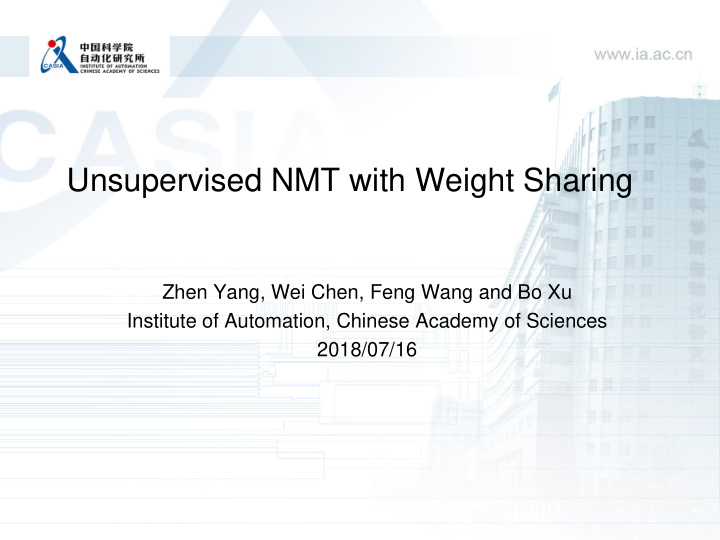



Unsupervised NMT with Weight Sharing Zhen Yang, Wei Chen, Feng Wang and Bo Xu Institute of Automation, Chinese Academy of Sciences 2018/07/16
Background 1 2 The proposed model Contents 3 Experiments and results 4 Related and future work
Background Assumption: different languages can be mapped into one shared-latent space
Techniques based on Initialize the model with inferred bilingual dictionary Unsupervised word embedding mapping Learn strong language model De-noising Auto-Encoding Convert Unsupervised setting into a supervised one Back-translation Constrain the latent representation produced by encoders to a shared space fully-shared encoder fixed mapped embedding GAN
We find The shared encoder is a bottleneck for unsupervised NMT The shared encoder is weak in keeping the unique and internal characteristics of each language, such as the style, terminology and sentence structure. Since each language has its own characteristics, the source and target language should be encoded and learned independently. Fixed word embedding also weakens the performance (not included in the paper) If you are interested about this part, you can find some discussions in our github code: https://github.com/ZhenYangIACAS/unsupervised-NMT
The proposed model: The local GAN is utilized to constrain the source and target latent representations to have the same distribution (embedding-reinforced encoder is also designed for this purpose, see our paper for detail). The global GAN is utilized to fine tune the whole model.
Experiment setup: Training sets : WMT16En-de, WMT14En-Fr, LDC Zn-En Note: The monolingual data is built by selecting the front half of the source language and the back half of the target language. Test sets : newstest2016En-de, newstest2014En-Fr, NIST02En-Zh Model Architecture : 4 self-attention layers for encoder and decoder Word Embedding : applying the Word2vec to pre-train the word embedding utilizing Vecmap to map these embedding to a shared-latent space
Experimental results: The effects of the weight-sharing layer number Layers for En-de En-Fr Zh-En sharing 0 10.23 16.02 13.75 1 10.86 16.97 14.52 2 10.56 16.73 14.07 3 10.63 16.50 13.92 4 10.01 16.44 12.86 Sharing one layer achieves the best translation performance.
Experimental results: The BLEU results of the proposed model: Baseline 1: the word-by-word translation according to the similarity of the word embedding Baseline 2: “unsupervised NMT with monolingual corpora only” proposed by Facebook. Upper Bound: the supervised translation on the same model.
Experimental results: Ablation study We perform an ablation study by training multiple versions of our model with some missing components: the local GAN, global GAN, the directional self-attention, the weight-sharing and the embedding-reinforced encoder. We do not test the importance of the auto-encoding, back-translation and the pre-trained embeddings since they have been widely tested in previous works.
Semi-supervised NMT (with 0.2M parallel data) Continue training the model after unsupervised training on the parallel data From scratch, training the model on monolingual data for one epoch, and then on parallel data for one epoch, and another one on monolingual data, on and on…. Models BLEU Only with parallel data 11.59 Fully unsupervised training 10.48 Continuing Training on supervised data 14.51 Jointly training on monolingual and parallel data 15.79
Related works: G. Lample, A. Conneau, L. Denoyer, and M. Ranzato. 2018. Unsupervised machine translation using monolingual corpora only . In International Conference on Learning Representations (ICLR). Mikel Artetxe, Gorka Labaka, Eneko Agirre, and Kyunghyun Cho. 2018. Unsupervised neural machine translation. In International Conference on Learning Representations (ICLR). G. Lample, A. Conneau, L. Denoyer, and M. Ranzato. 2018 Phrase-Based & Neural Unsupervised Machine Translation (arxiv) * The newest paper (third one) proposes the shared BPE method for unsupervised NMT, its effectiveness is to be verified (around +10 BLEU points improvement is presented).
Future work: Continuing testing the unsupervised NMT and seeking to find its optimal configurations. Testing the performance of semi-supervised NMT with a little amount of bilingual data. Investigating more effective approach for utilizing the monolingual data in the framework of unsupervised NMT.
Code and new results can be found at: https://github.com/ZhenYangIACAS/unsupervised-NMT
Recommend
More recommend